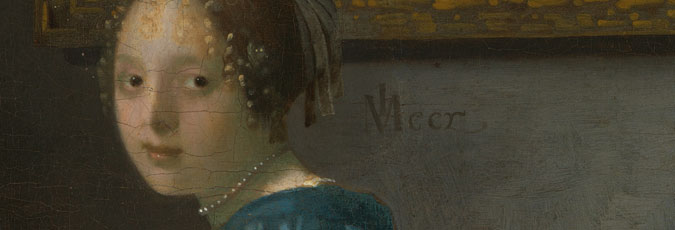Introduction
National Gallery researchers analysed four paintings by Vermeer on display in the 2013 summer exhibition Vermeer and Music: The Art of Love and Leisure.
This visual examination and technical imaging was conducted to understand the current conditions of the paintings and how this may relate to the alteration of Vermeer's original painting materials and to conservation treatments undertaken in the past.
Read a full introduction to the project
The methods used in the study are outlined here.
Methods
The first stage of examination involved a visual inspection of the paintings in normal, raking and ultraviolet (UV) light. This was followed by detailed examination at magnification with the aid of a binocular microscope. Infrared imaging was also undertaken and X-ray images acquired.
To supplement the samples taken in the 1960s a few additional paint samples were taken to elucidate specific aspects of the original technique and alteration phenomena.
Paint samples were initially examined at 10-45x magnification with a binocular microscope, photographed and their stratigraphy (layer structure) documented. A portion of the sample was then mounted as a polished cross-section and examined with an optical microscope in incident and UV light. To confirm pigment identifications made by microscopy, additional instrumental analyses were undertaken using a scanning electron microscope with energy-dispersive X-ray microanalysis (SEM-EDX). Identification of organic materials and additional confirmation of inorganic components was accomplished using (attenuated total reflectance) Fourier transform infra-red microscopy (ATR-FTIR). Gas chromatography – mass spectrometry (GC-MS) analysis was employed to study the binding medium of paint samples.
The instrumental methods employed in this study are described in more detail on the following pages.

